

HTRF Human Total KRAS Detection Kit, 10,000 Assay Points


HTRF Human Total KRAS Detection Kit, 10,000 Assay Points






This HTRF kit allows for the cell-based quantitative detection of Total KRAS.
For research use only. Not for use in diagnostic procedures. All products to be used in accordance with applicable laws and regulations including without limitation, consumption and disposal requirements under European REACH regulations (EC 1907/2006).
| Feature | Specification |
|---|---|
| Application | Cell Signaling |
| Sample Volume | 16 µL |
This HTRF kit allows for the cell-based quantitative detection of Total KRAS.
For research use only. Not for use in diagnostic procedures. All products to be used in accordance with applicable laws and regulations including without limitation, consumption and disposal requirements under European REACH regulations (EC 1907/2006).



HTRF Human Total KRAS Detection Kit, 10,000 Assay Points



HTRF Human Total KRAS Detection Kit, 10,000 Assay Points



Product information
Overview
KRAS is a monomeric GTPases that relays signals from receptor tyrosine kinases promoting cell proliferation, differentiation or survival. KRAS is one of the most frequently mutated oncogenes in cancer. Mutation is commonly associated with poor prognosis and resistance to therapy. The KRAS G12C mutation is one of the more common KRAS mutations. KRAS G12C is constitutively active, in a persistently GTP-bound state, resulting in overstimulation of the KRAS effector signaling MAPK pathways and driving tumor growth.
Specifications
| Application |
Cell Signaling
|
|---|---|
| Brand |
HTRF
|
| Buffer/Solvent |
Lysis Buffer 6
|
| Detection Modality |
HTRF
|
| Host Species |
Human
|
| Lysis Buffer Compatibility |
Lysis Buffer 1
Lysis Buffer 4
|
| Molecular Modification |
Total
|
| Product Group |
Kit
|
| Sample Volume |
16 µL
|
| Shipping Conditions |
Shipped in Dry Ice
|
| Target |
KRAS
|
| Target Class |
Phosphoproteins
|
| Target Species |
Human
|
| Technology |
TR-FRET
|
| Therapeutic Area |
Inflammation
Oncology
|
| Unit Size |
10,000 Assay Points
|
Video gallery

HTRF Human Total KRAS Detection Kit, 10,000 Assay Points

HTRF Human Total KRAS Detection Kit, 10,000 Assay Points

How it works
Total KRAS assay principle
The Total KRAS assay quantifies the expression level of KRAS in a cell lysate. Unlike Western Blot, the assay is entirely plate-based and does not require gels, electrophoresis, or transfer. The Total KRAS assay uses two labeled antibodies, one coupled to a donor fluorophore and the other to an acceptor. Both antibodies are highly specific for a distinct epitope on the protein. In the presence of KRAS in a cell extract, the addition of these conjugates brings the donor fluorophore into close proximity with the acceptor and thereby generates a FRET signal. Its intensity is directly proportional to the concentration of the protein present in the sample, and provides a means of assessing the protein's expression under a no-wash assay format.

Total KRAS two-plate assay protocol
The two-plate protocol involves culturing cells in a 96-well plate before lysis, then transferring lysates into a 384-well low volume detection plate before the addition of HTRF Total KRAS detection reagents. This protocol allows for the cells' viability and confluence to be monitored.
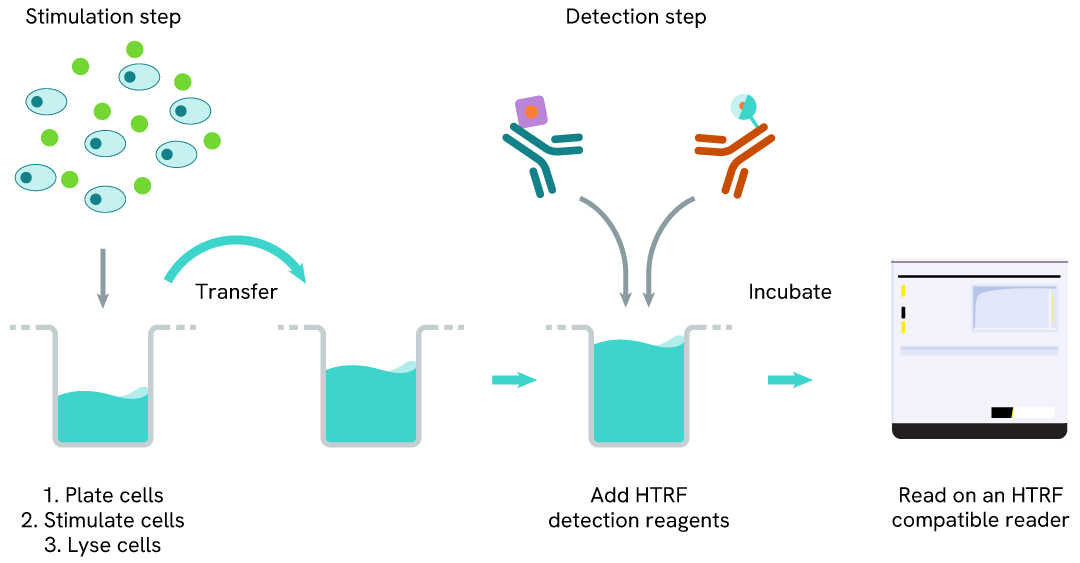
Total KRAS one-plate assay protocol
Detection of Total KRAS with HTRF reagents can be performed in a single plate used for culturing, stimulation, and lysis. No washing steps are required. This HTS designed protocol facilitates miniaturization while maintaining robust HTRF quality.
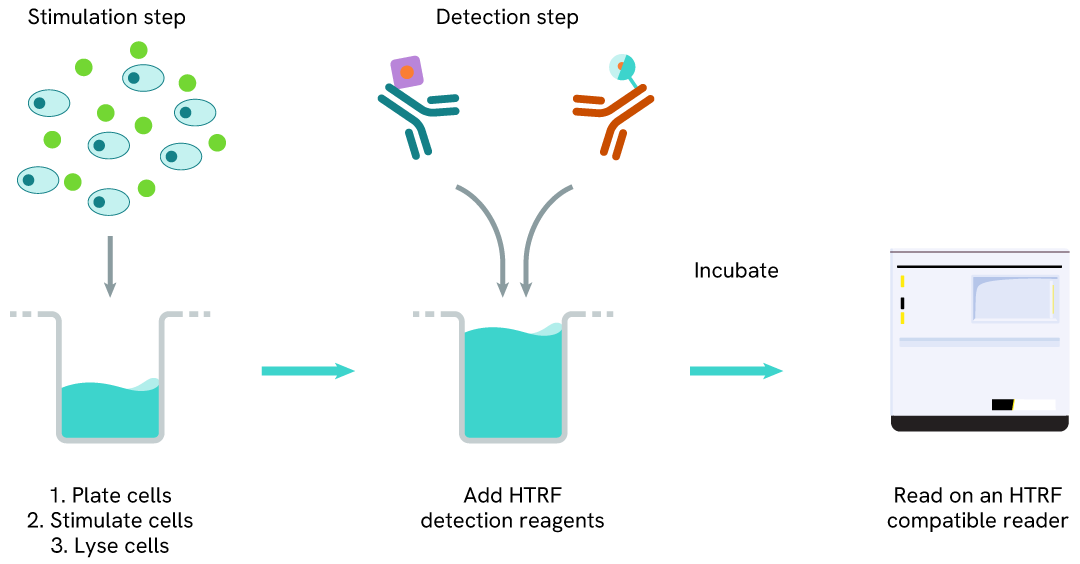
Assay validation
Selective degradation of KRAS G12C using PROTAC® across multiple cell lines
Mia-Paca-2, SW1573, and Calu-1 cells were seeded in a 96-well culture-treated plate at a density of 100,000 cells per well in complete culture medium and incubated overnight at 37°C with 5% CO2. The following day, cells were treated for 24 hours with increasing concentrations of LC-2 PROTAC, which is designed to induce degradation of the KRAS G12C mutant, and MRTX-849, a covalent inhibitor of KRAS G12C and LC-2 PROTAC warhead. For control conditions, cells were pre-incubated with the proteasome inhibitor Epoxomicin (1 µM) for 1 hour at 37°C prior to the addition of the PROTAC.
After treatment, the cells were lysed with 50 µL of supplemented lysis buffer #6 for 30 minutes at room temperature under gentle shaking. Subsequently, 16 µL of the lysates, half-diluted in supplemented lysis buffer #6, were transferred into a ProxiPlate-384 (#6008280/9), and 4 µL of HTRF Total KRAS detection antibodies were added. The HTRF signal was recorded after an overnight incubation at room temperature.
In parallel, 4 µL of lysates (supplemented with 12 µL of diluent #8) were transferred to a microplate, and the alpha-tubulin housekeeping protein was detected using the HTRF Alpha-tubulin Housekeeping Cellular Kit (64ATUBPEG/H). The HTRF signal was recorded after an overnight incubation.
The LC-2 PROTAC triggered a dose-dependent decrease in KRAS protein levels in all three cell lines, whereas the specific KRAS G12C inhibitor MRTX-849 did not. The lack of KRAS decrease observed in the presence of epoxomicin confirmed that the degradation was driven by the ubiquitin-proteasome system. Under the same experimental conditions, the level of alpha-tubulin remained unchanged (data not shown).
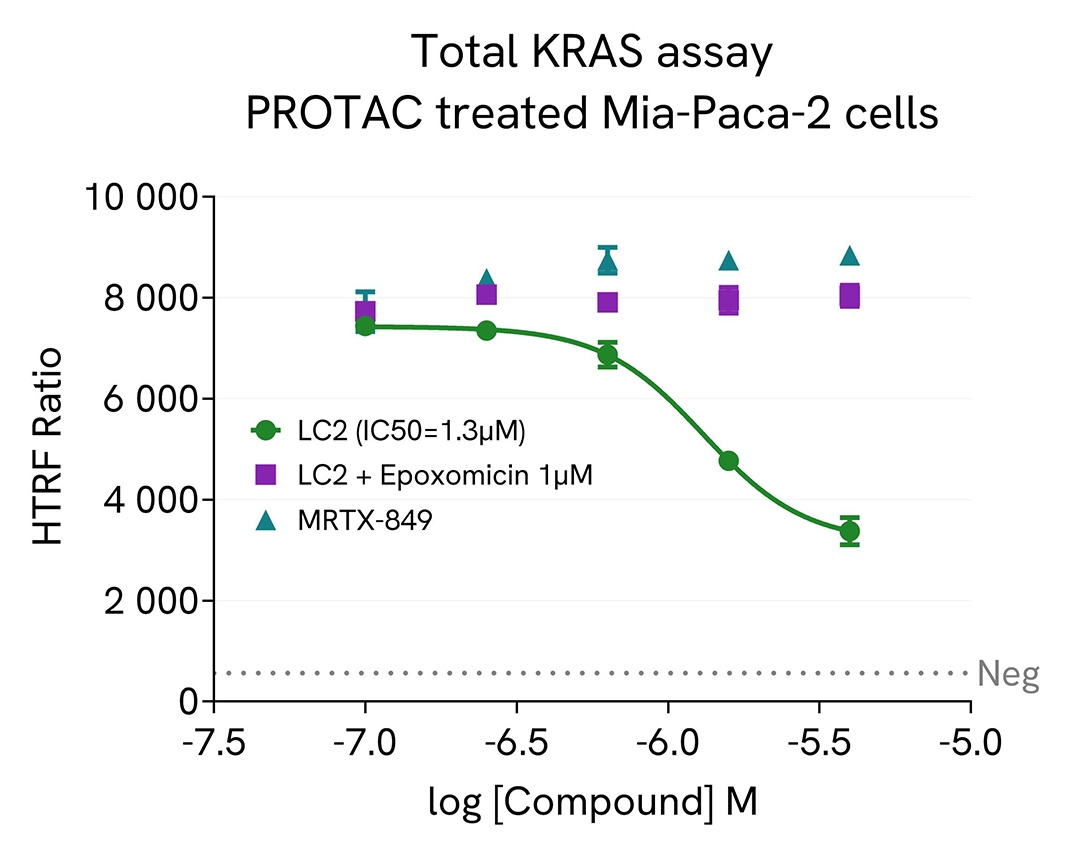
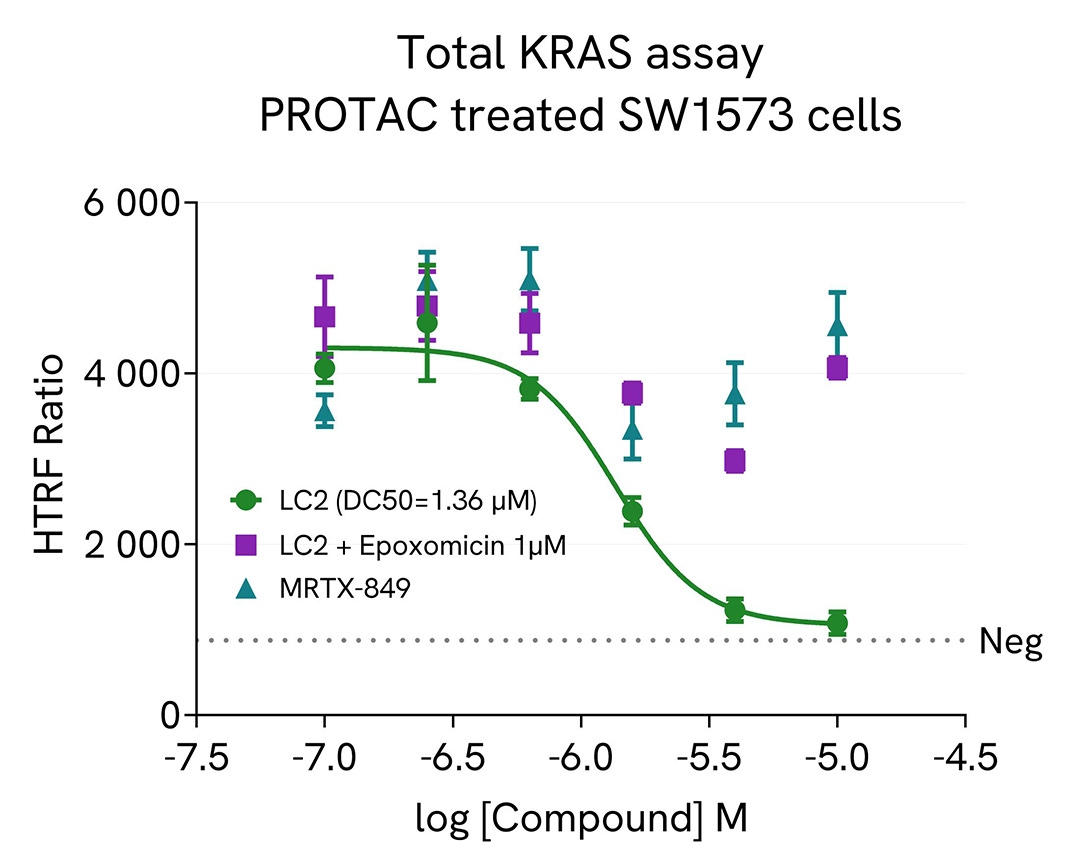
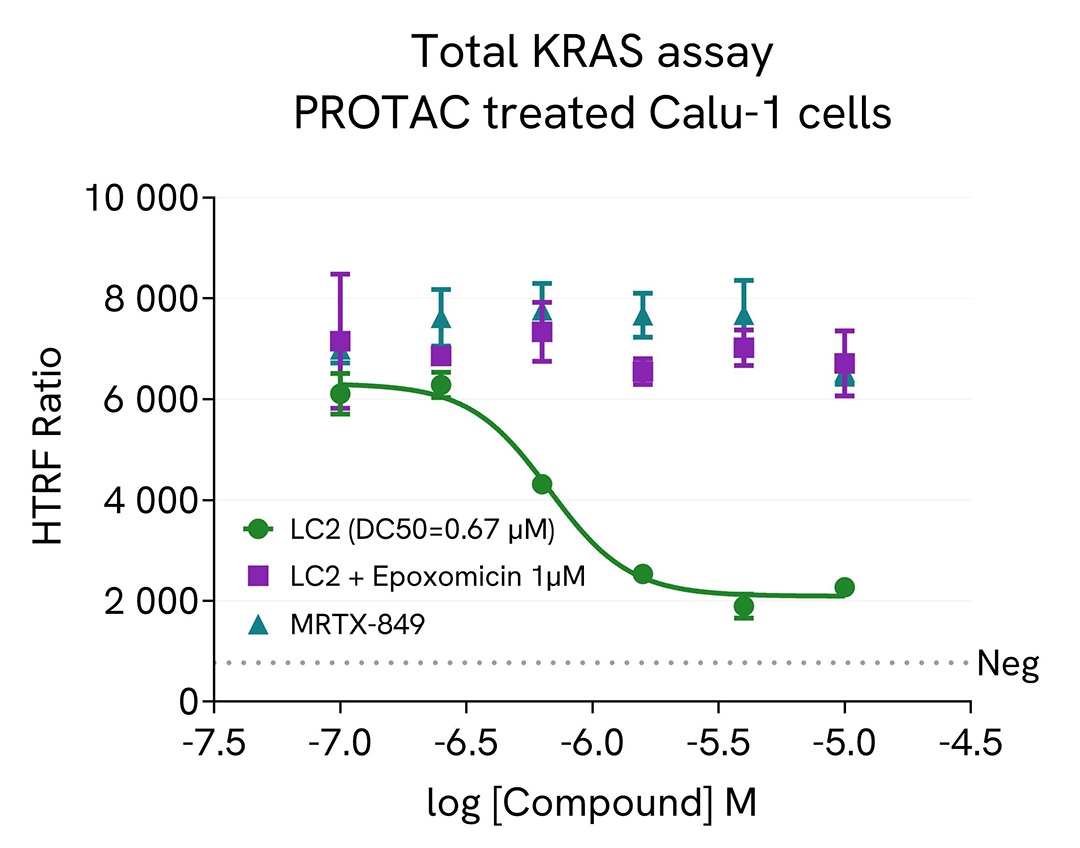
Validation of HTRF total KRAS assay specificity using HAP-1 KRAS KO cell line
RNA expression levels of KRAS, HRAS, and NRAS genes were quantified in HAP-1 cells, according to data from Revvity’s Horizon Discovery team. The results indicate significant RNA expression for all three genes in HAP-1 cells (catalog reference Revvity’s Horizon Discovery product: HAP1 WT #C631).
Cell lysates from HAP1-WT and HAP1-KRAS KO cells (catalog reference Revvity’s Horizon Discovery product: HAP1 KO KRAS #HZGHC005816c001) were prepared and tested using the HTRF Total KRAS kit to validate the specificity of KRAS detection. This assay aimed to ensure detection of KRAS without cross-reactivity to NRAS and HRAS.
The results showed no HTRF signal detection in HAP-1 KRAS KO cells, which express NRAS and HRAS, confirming the kit's specificity for detecting KRAS exclusively.
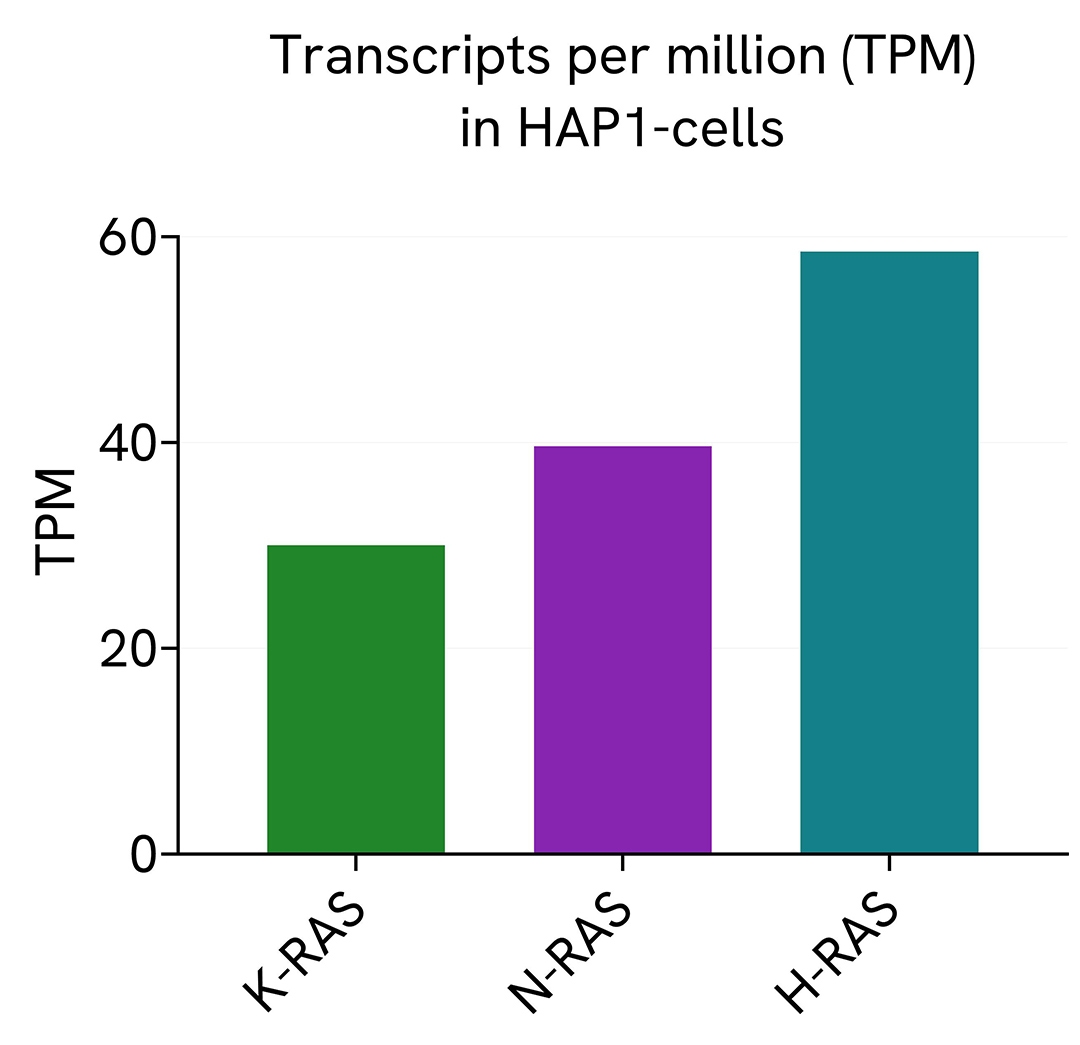
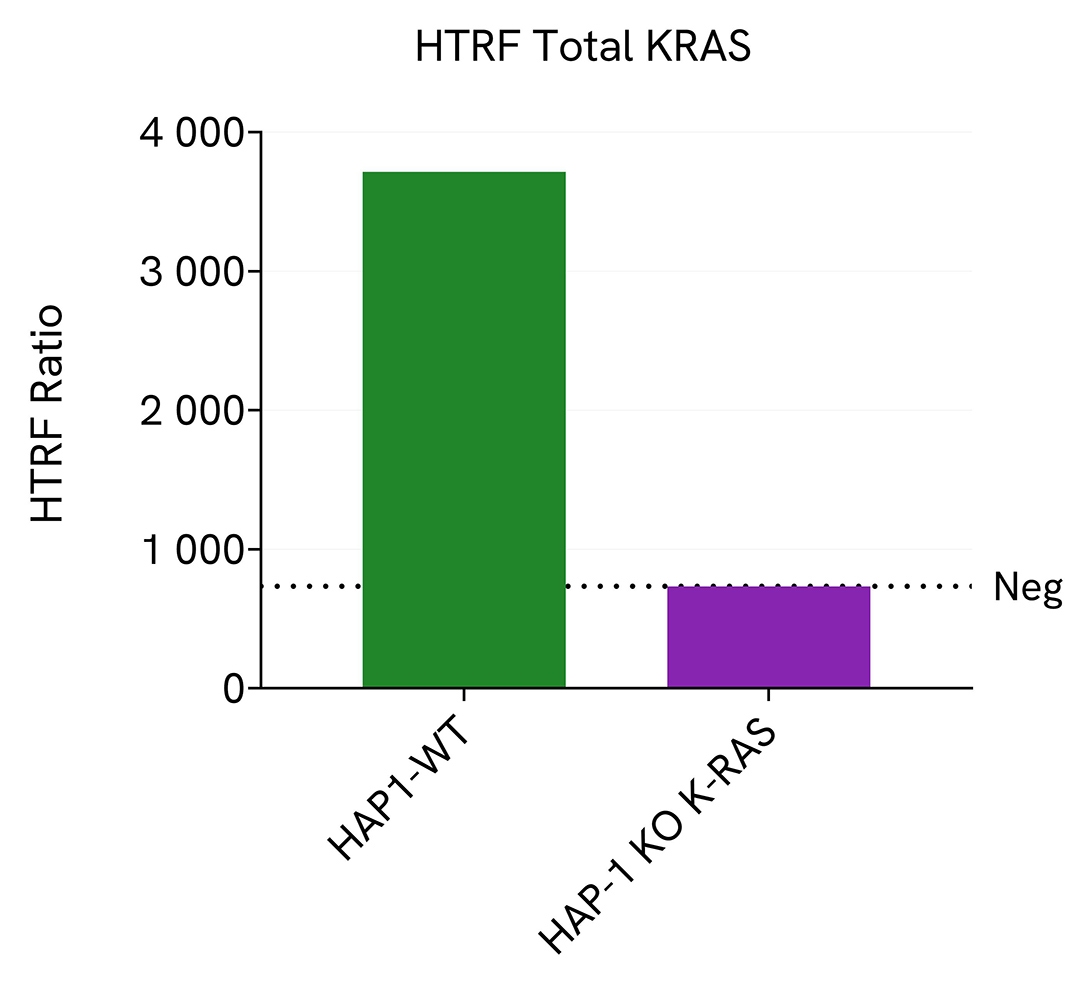
Quantification of Total KRAS expression level in various cell lines
Cell lysates from various commercially available cell lines with different genotype profiles at codon 12 were prepared and tested using the HTRF Total KRAS kit. Significant detection of KRAS expression was observed in all cell lines tested (see table).
KRAS levels were monitored using the HTRF Total KRAS kit in three homozygous cell models expressing KRAS G12C and one model expressing both WT and G12C alleles. The HTRF Alpha-tubulin Housekeeping Cellular Kit (64ATUBPEG/H) was used to detect alpha-tubulin expression as a reference gene.
| Commercial cell lines | Zygosity on codon 12 | HTRF KRAS Total kit |
|---|---|---|
| HT-29 | Homo WT | ✓ |
| RKO | Homo WT | ✓ |
| HCT-116 | Homo WT | ✓ |
| SW1463 | Homo G12C | ✓ |
| SW1573 | Homo G12C | ✓ |
| Mia-PaCa-2 | Homo G12C | ✓ |
| Calu-1 | Homo G12C | ✓ |
| AsPC-1 | Homo G12D | ✓ |
| SW480 | Homo G12V | ✓ |
| NCI-H358 | Hetero G12C/WT | ✓ |
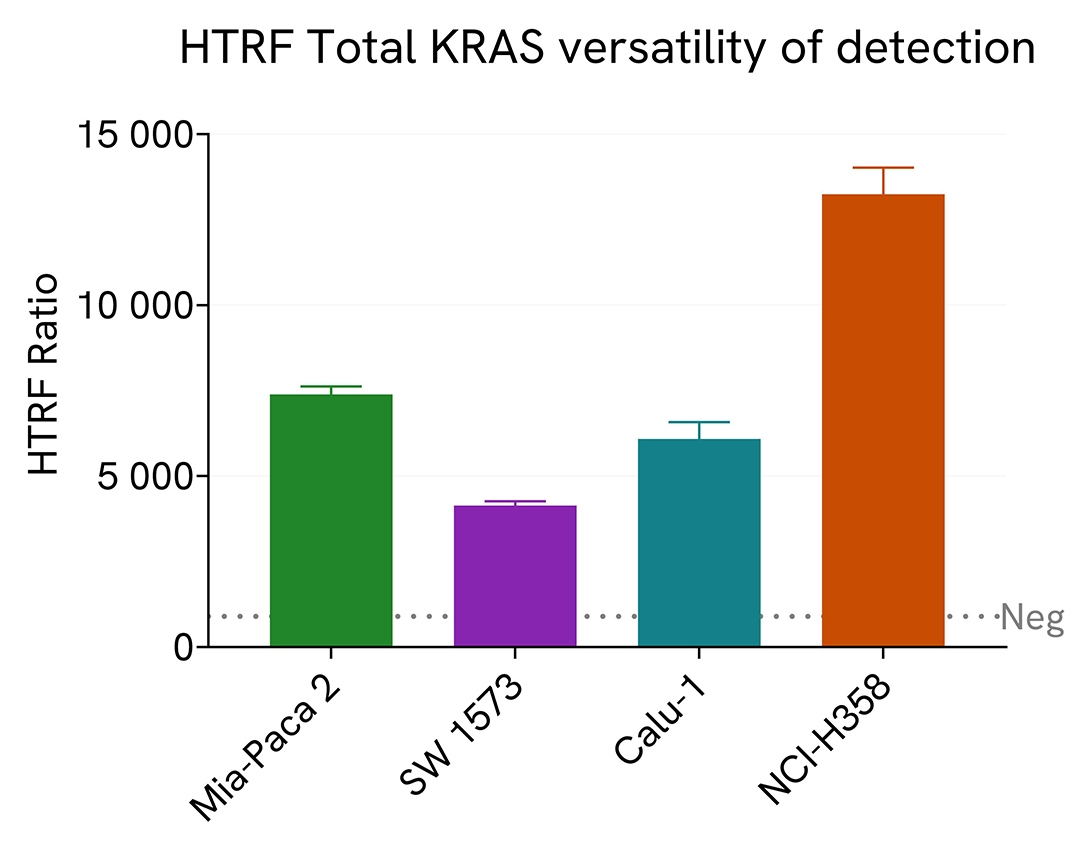
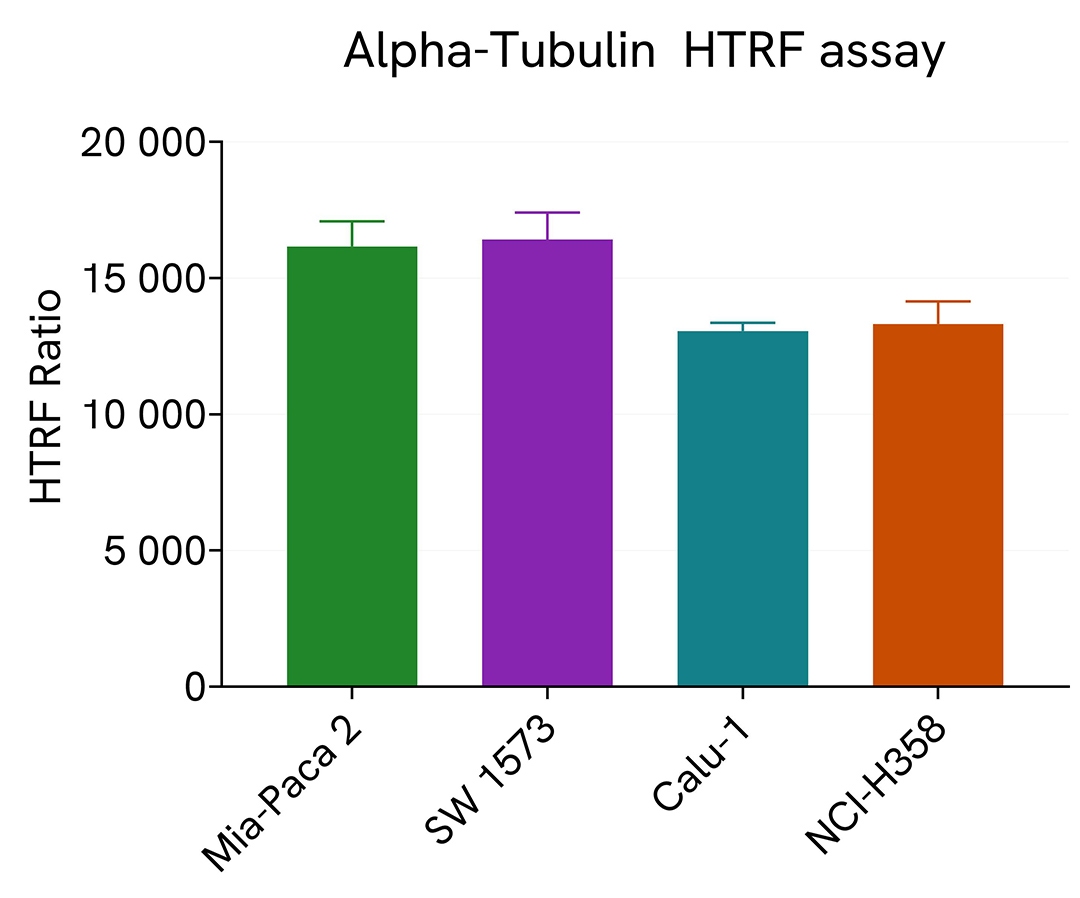
HTRF Total KRAS assay compared to Western Blot
SW480 cells were grown in a T175 flask in complete culture medium at 37°C - 5% CO2 until 80% confluence. After medium removal, cells were lysed with 3 mL of supplemented lysis buffer (1X) for 30 minutes at RT under gentle shaking.
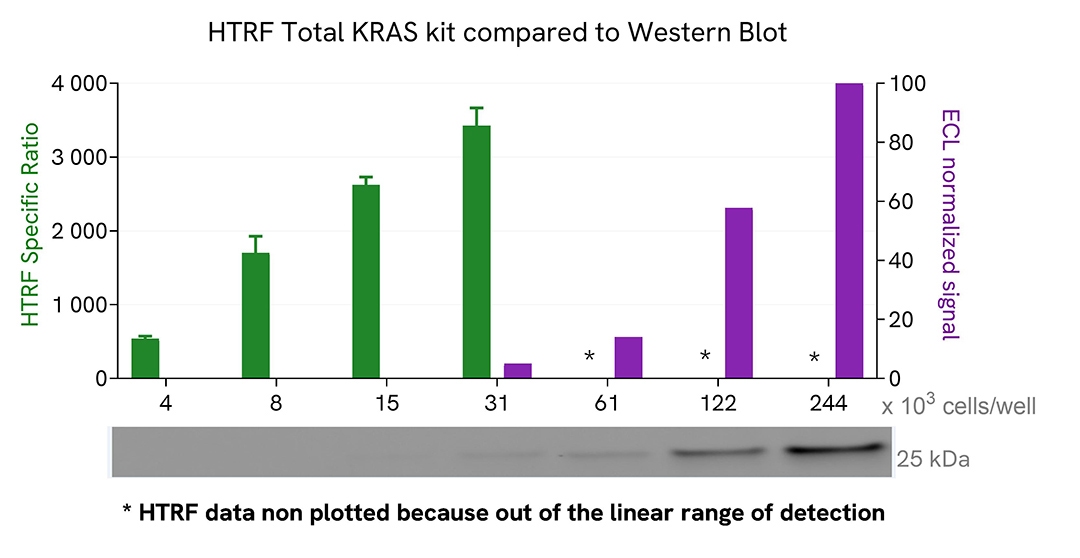
Serial dilutions of the cell lysate were performed using supplemented lysis buffer, and 16 µL of each dilution were transferred into a low volume white microplate before the addition of 4 µL of HTRF Total KRAS detection reagents. Equal amounts of lysates were used for a side-by-side comparison between HTRF and Western Blot.
Using the HTRF Total KRAS assay, 4000 cells/well were enough to detect a significant signal, while 31000 cells were needed to obtain a minimal chemiluminescent signal using Western Blot. Therefore, in these conditions, the HTRF Total KRAS assay was 7.5 times more sensitive than the Western Blot technique.
Simplified pathway
KRAS signaling pathway
KRAS, a small GTPase, acts as a molecular switch, cycling between an active GTP-bound state and an inactive GDP-bound state. Upon activation by upstream signals, such as growth factors binding to receptor tyrosine kinases (RTKs), KRAS activates multiple downstream effector pathways, most notably the RAF-MEK-ERK and PI3K-AKT pathways. The RAF-MEK-ERK pathway promotes cell proliferation and differentiation, while the PI3K-AKT pathway supports cell survival and metabolism. Mutations in KRAS, particularly at codon 12, 13, and 61, can lock KRAS in its active state, leading to uncontrolled cell division and cancer. This dysregulation is common in various cancers, including pancreatic, colorectal, and lung cancers.
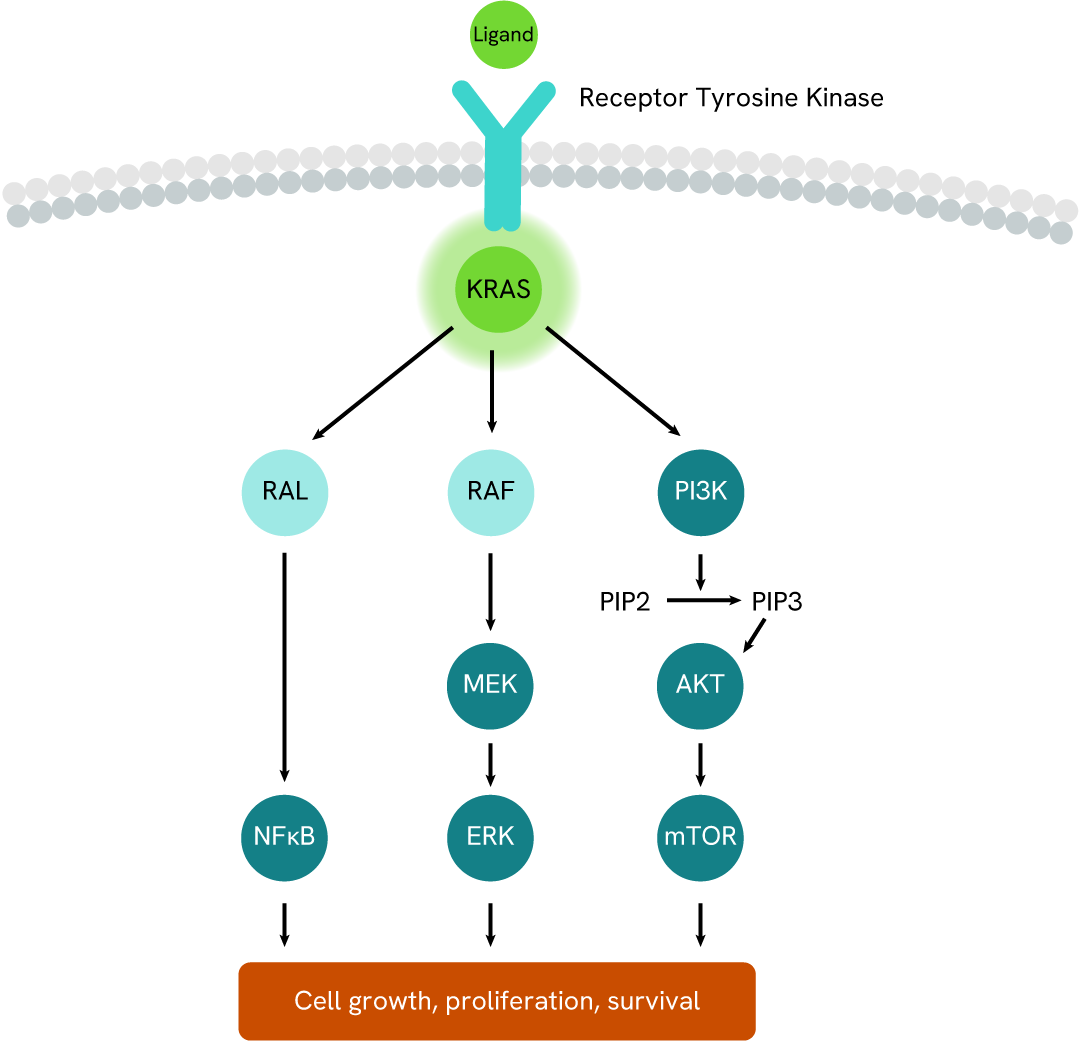
Resources
Are you looking for resources, click on the resource type to explore further.
The RAS family of genes, particularly K-Ras, plays a critical role in cancer biology. Despite its notorious difficulty as a...
This guide provides you an overview of HTRF applications in several therapeutic areas.
This document includes detailed tables listing HTRF™, AlphaLISA™ SureFire® Ultra™, and Alpha SureFire® Ultra™ Multiplex assays...


How can we help you?
We are here to answer your questions.






























